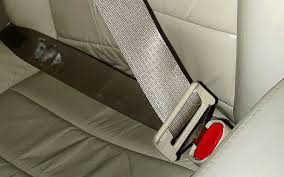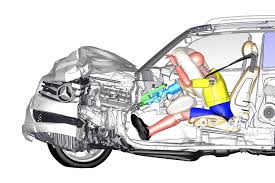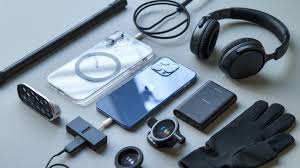Vehicle safety features such as seatbelts, airbags, crumple zones are the three pillars of occupant protection in modern cars. In this comprehensive 2025 guide you’ll learn how these systems — together with advanced crash protection systems and road safety technologies — reduce injuries and fatalities, what testing standards to trust, and practical tips for choosing and maintaining safety features on your vehicle.
1. Why vehicle safety features matter:
Road crashes are a leading cause of death and injury worldwide. While infrastructure, enforcement and driver behavior are vital, vehicle design and onboard safety systems directly determine survival chances in a crash. Seatbelts reduce ejection and blunt force impacts, airbags cushion the head and chest, and crumple zones absorb kinetic energy — together they lower severe injury risk dramatically. Modern active systems (like automatic emergency braking) aim to prevent many crashes in the first place.
2. The three core systems: seatbelts, airbags, crumple zones:

At their simplest:
- Seatbelts restrain occupants and manage deceleration forces.
- Airbags provide a rapid, controlled cushion between occupant and hard surfaces.
- Crumple zones deform on impact to absorb crash energy and lower the forces transmitted to occupants.
These are passive safety features — they act during or after a collision — but are designed today to work with active systems (e.g., pre-tensioners trigger seatbelt tightening when sensors predict an imminent crash).
3. How seatbelts work — types, technology and best practices:
Types of seatbelts:
- Lap belt: basic restraint across the pelvis — now rare as sole protection.
- 3-point belt: shoulder + lap — standard for front and rear outboard seats.
- 4- and 5-point harnesses: used in motorsport and child seats for superior restraint.
- ISOFIX/LATCH anchor systems: secure child seats to the vehicle structure, reducing misuse.
Key seatbelt technologies:
- Pretensioners: tighten the belt immediately when sensors detect a crash, minimizing slack.
- Load limiters: allow limited webs to spool out under extreme load to reduce chest injuries.
- Adaptive pretensioners & pre-crash systems: work with ADAS to pre-arm belts seconds before an impact.
- Seatbelt reminders and interlocks: systems that notify occupants to buckle up.
Best practices:
- Always wear a 3-point belt, across the pelvis (not the stomach) and shoulder (not under the arm).
- Children should sit in appropriate child seats or boosters with ISOFIX when available.
- Replace seatbelts or components after a moderate or severe crash; webbing can be damaged even without visible signs.
- Don’t route belts behind the back or under the arm — this drastically reduces effectiveness.
4. Airbags explained — types, deployment logic and safety considerations:
Types of airbags:
- Front airbags: driver and passenger frontal impact protection.
- Side airbags: torso and head protection for side impacts.
- Curtain airbags: deploy from roof lining to protect heads in side impacts and rollovers.
- Knee airbags: reduce lower extremity injuries.
- Center airbags: prevent occupant-to-occupant contact in frontal crashes.
- Rear airbags: emerging for rear passenger protection in high-end models.
How airbags deploy:
Airbag systems use crash sensors and an airbag control unit (ACU). When threshold deceleration is met, the ACU ignites a propellant to rapidly generate gas (commonly nitrogen) that inflates the bag in ~20-50 ms. Deployment force and timing vary by crash severity, occupant size/position and seatbelt use.
Airbag safety considerations:
- Seat position matters: leaning forward increases risk of injury from deploying airbags.
- Rear-facing infant seats: never place in front seat with active airbag.
- Occupant detection: modern cars use seat sensors to suppress passenger airbags when a child seat is detected.
- After airbag deployment the module must be replaced; do not drive a car without properly repaired airbag systems.
Advances in airbag technology:
- Multi-stage airbags inflate to different volumes based on crash.
- Adaptive deployment using occupant size and seat sensors.
- Soft-deploy curtain airbags for improved lateral protection without injuring occupants.
5. Crumple zones & chassis design — energy absorption and crash management:
What are crumple zones?
Crumple zones are engineered areas (usually front and rear) designed to deform controllably in a collision. The goal is to convert kinetic energy into deformation work, reducing peak deceleration experienced by occupants.
How they work:
- Controlled deformation patterns: thin sections, folds, and structural elements collapse progressively.
- Load paths and survival cell: while crumple zones absorb energy, the passenger cell (survival cell) is reinforced to remain intact.
- Material engineering: high-strength steels, aluminum alloys, and structural adhesives create strength where needed and crush where required.
Design evolution:
Modern cars use crash boxes, energy-absorbing subframes, and computational crash modeling to tune crumple performance. Innovations like modular front subframes and mixed material architectures improve energy management while keeping weight down.
6. How these systems interact in a crash — the safety system cascade:
A crash sequence:
- Sensors detect imminent collision (time before impact).
- Pretensioners activate to remove slack from belts.
- Crumple zones begin to deform, absorbing energy.
- Airbags deploy at calculated force/timing to cushion the head/chest.
- Load limiters allow controlled belt payout to reduce chest injury.
- Occupant cell remains intact, minimizing intrusion.
This coordinated response is critical. For example, airbags are designed to work with seatbelts — a deployed airbag without a seatbelt increases risk of injury.
7. Modern crash protection systems (AEB, ESC, lane assist, ADAS):
Beyond passive systems, modern vehicles include active technologies that prevent or reduce crash severity.
Key active safety systems:
- Autonomous Emergency Braking (AEB): detects imminent collisions and applies brakes automatically.
- Electronic Stability Control (ESC): reduces skid and loss of control.
- Lane Keep Assist (LKA) / Lane Departure Warning (LDW): helps prevent unintentional lane drift.
- Adaptive Cruise Control (ACC): maintains safe following distance.
- Blind-spot detection & Rear Cross-Traffic Alert (RCTA).
How active and passive systems combine:
Active systems reduce crash likelihood and severity. If a collision does occur, passive systems (seatbelts, airbags, crumple zones) mitigate consequences. The result: improved real-world safety outcomes when both generations of technology are present.
7. Safety testing and ratings — IIHS, NHTSA, Euro NCAP explained:
IIHS (Insurance Institute for Highway Safety):
- US-based nonprofit that runs crash tests (small overlap front, moderate overlap front, side, roof strength, head restraints) and awards Top Safety Pick/Top Safety Pick+ ratings. IIHS also evaluates headlight performance and crash avoidance technologies (AEB, lane support).
NHTSA (National Highway Traffic Safety Administration):
- US federal agency that conducts New Car Assessment Program (NCAP) tests with star ratings (frontal, side, rollover). NHTSA focuses on occupant protection and rollover resistance.
Euro NCAP:
- European testing program that includes adult and child occupant protection, pedestrian protection, and safety assist (ADAS) scoring, producing star ratings.
How to read ratings:
- Look for high scores in both crash protection and crash prevention categories.
- Top-rated vehicles often combine strong structure, airbags, seatbelt systems, and comprehensive ADAS.
External resources:
- IIHS: https://www.iihs.org/
- NHTSA: https://www.nhtsa.gov/
- Euro NCAP: https://www.euroncap.com/
9. Regulations, mandatory equipment and global differences:
- In many countries, front 3-point seatbelts and front airbags are mandatory.
- Some regions require ESC as standard equipment for new cars.
- Child restraint laws vary widely — check local regulations for proper installation and legal requirements.
- Crash test adoption and enforcement differ by market — a vehicle sold in one region may have different standard safety equipment elsewhere.
10. Real-world effectiveness — statistics and case studies:
- Seatbelts reduce fatal injury risk to front-seat occupants by about 45% and cut moderate-to-critical injuries by 50% or more.
- Airbags in combination with seatbelts reduce driver fatality risk by approximately 14% to 50% depending on crash type and vehicle era.
- Crumple zones and improved vehicle structures have reduced the severity of frontal collisions over the decades, demonstrated by lower fatality rates per mile traveled in modern vehicles.
Case study: modern small-overlap crash testing shows that cars with updated structures + side curtain airbags preserve occupant survival space, lowering severe head and chest injuries.
(Statistics referenced from IIHS, NHTSA and global safety reports.)
11. Choosing a safe car in 2025 — checklist and recommended models:
Safety checklist:
- 5-star NCAP or Top Safety Pick rating (or regional equivalent).
- ESC standard on all trims.
- Multiple airbags (front, side, curtain).
- Seatbelt pretensioners and load limiters.
- AEB with pedestrian/cyclist detection.
- ISOFIX/LATCH anchors for child seats.
- Strong structural ratings (small overlap and side impact).
- Headlight performance rating (IIHS).
Recommended modern safety-rich models (examples; check local ratings):
- Mid-size and larger sedans and SUVs from manufacturers with strong safety focus (brands like Volvo, Mercedes-Benz, Subaru, Toyota, Hyundai/Kia, Honda often score well). Always consult local IIHS/Euro NCAP/NHTSA scores for specific trims.
Maintenance, repairs and after-market safety considerations:
Post-crash repair quality:
- Always have airbag modules, seatbelts and structural components repaired or replaced by certified technicians.
- After-market parts or poor repairs can compromise safety performance in future crashes.
Regular inspection:
- Check seatbelt webbing for frays/cuts and ensure retraction works.
- Verify airbag warning lights: a persistent light indicates a fault requiring diagnostic attention.
- Monitor vehicle recalls — manufacturers may issue mandatory fixes for safety defects.
Aftermarket modifications:
- Lowering suspension, removing airbags, or changing seat anchor points can reduce crash protection. Avoid unauthorized modifications.
13. Myths and misconceptions about airbags and seatbelts:
“Airbags are dangerous — better to turn them off.”
False. Airbags are designed as a supplemental system. When used with seatbelts, they save lives. In rare cases (very small children, unrestrained occupants sitting too close), airbags can cause injury — which is why correct seating and child-seat placement matter.
“If you drive slowly, seatbelts aren’t necessary.”
False. Even at low speeds, collisions can produce forces sufficient to cause injury or ejection. Seatbelts are the first line of defense.
14. Future trends in vehicle safety — active safety, AI, and passive improvements:
Active prevention:
- Advanced driver assistance systems (ADAS) will evolve into higher levels of automation, reducing human error.
- AI-powered sensor fusion (camera, radar, lidar) will improve detection of vulnerable road users (pedestrians, cyclists).
Integrated occupant monitoring:
- Seat occupancy/biometric sensors to adapt airbag deployment and seatbelt force for individual size and posture.
- Connected vehicle safety, where networks share hazard information in real time.
New passive tech:
- Smart materials that deform more predictably under impact.
- External airbags (pedestrian protection) and deployable bumpers for vulnerable road users.
- Lightweight structural solutions that don’t sacrifice crash performance.
15. Conclusion & resources:
Vehicle safety features — seatbelts, airbags, crumple zones — and modern crash protection systems together save lives. When shopping for a car, prioritize tested safety performance, required passive systems, and modern active safety features. Keep equipment maintained, obey fitment rules, and stay informed about recalls and safety advisories.
16. Authoritative resources & further reading:
- NHTSA — National Highway Traffic Safety Administration: https://www.nhtsa.gov/
- IIHS — Insurance Institute for Highway Safety: https://www.iihs.org/
- Euro NCAP: https://www.euroncap.com/
- WHO — Road Safety: https://www.who.int/health-topics/road-safety
- Global NCAP: https://www.globalncap.org/




Leave a Reply